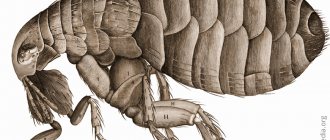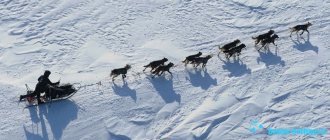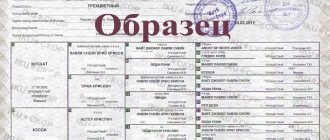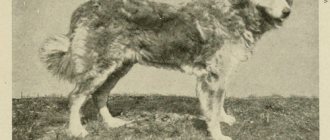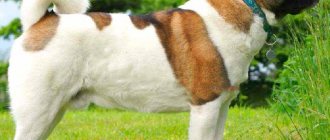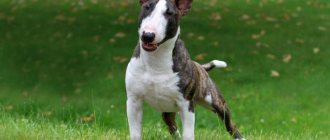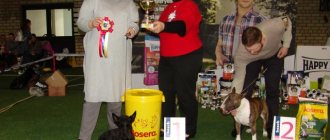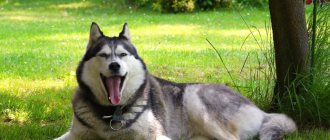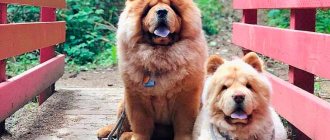Stafford fights
The first breed standard was approved on June 10, 1936. His project was created by W. Brandon, later the first president of the Staffordshire Terrier Club of America (STCA), based on study of other breed standards, detailed discussion and careful coordination with like-minded people. Without any changes, it was adopted by the Fédération Cynologique Internationale and is its official document.
General form
The American Staffordshire Terrier should give the impression of being a dog of great strength for its size, well built, muscular, but at the same time elegant, agile and very responsive to its surroundings. The American Staffordshire Terrier should be stocky in appearance, not long-legged or greyhound-like. His courage is legendary.
Head
Medium length, deep, wide, with clearly defined muscles and a distinct transition from forehead to muzzle. The ears are set high, cropped or undocked. The latter are preferred. Uncropped ears should be short and carried semi-erect or erect. Completely drooping ears are rejected. The eyes are dark, round, deep-set and widely spaced. Pink eyelids are not acceptable. The muzzle is of medium length, with a sharp transition to the skull, not lowered. The bridge of the nose is rounded. The jaws are clearly defined. A strong lower jaw provides a powerful grip. The lips are dense, close-fitting, not droopy. The upper incisors meet the front of the lower incisors. The nose is always black.
Neck
Massive, slightly curved, tapering from the shoulders to the back of the head, medium length, without dewlap.
Shoulders
Strong and muscular, with wide, obliquely set shoulder blades.
Topline
Quite short, with a slight slope from the withers to the croup and a smooth short slope of the croup to the base of the tail.
Stomach
Slightly tucked up.
Frame
The chest is wide and deep throughout, with fairly convex, tightly packed ribs. The forelimbs are widely spaced, which results in a well-developed chest. Tail. Short compared to the size of the dog. Low set, tapering towards the end. Not hooked, not thrown over the back. Undocked.
Limbs
The forelimbs are straight, with powerful rounded bones. Pasterns are vertical. The hind limbs are very muscular. Hocks moderately short. The hocks are turned neither in nor out. The paws are of medium size, well arched and well-knit. The movements are springy. Ambling is a vice.
Color
Any color is allowed - single-color, particolor, spotted. Pure white color or white color exceeding 80% of the body surface, as well as black and tan or liver are undesirable.
Height and weight
Definitely proportional. Height at the withers is about 46-48 cm for males and 44-46 for females.
Flaws
A fleshy or light brown nose, light eyes or pink eyelids, a tail that is too long or worn incorrectly, undershot or undershot.
The first breed standard was approved on June 10, 1936. His project was created by W. Brandon, later the first president of the Staffordshire Terrier Club of America (STCA), based on study of other breed standards, detailed discussion and careful coordination with like-minded people. Without any changes, it was adopted by the Fédération Cynologique Internationale and is its official document.
What is the difference between a pit bull and a stafford?
How do I understand those people who carefully examine the representatives of these two breeds and try to understand what are the differences? There never seemed to be any difficulty. The St. Bernard was easily distinguished from the Newfoundland, there were no problems in identifying the Doberman, it was immediately clear that this was not a Rottweiler. And what is the difference between a pit bull and a Stafford is impossible to see and understand. I suspect that for many, my next words will significantly ease their hopeless misunderstanding. Because there are no differences, because, by and large, we are talking about the same breed, the breeding of which has long been divided into two fundamental areas: exterior and working.
Of course, the pit bull got a very specific job: he had to win dog fights. Of course, this is immoral and cruel, but what can you take from a person? Not just dogs, he put himself up for gladiatorial fights with his own kind. From this perspective, there is no reason to be surprised that he prepared the same mission for his smaller four-legged brothers. Nowadays, dog fighting has long been prohibited, but the breed has been perfectly preserved.
This story begins a long time ago - with the ancestors of both breeds: the English Terrier and the English Bulldog were brought to the United States in 1870. We can assume that selection began then. She was formed according to two qualities: exterior and working. There has been no talk of division yet. In 1921, the American Pit Bull Terrier Club was created, and selection work began on breeding pit bulls, but without game. Up to this point, it was the same test as for OKD German Shepherds. In 1936, the Staffordshire Terrier breed was recognized and officially registered, and accordingly its standard was approved. In 1972, the breed received a slightly different name - American Staffordshire Terrier, the breed standard changed slightly, and in the same year official recognition was received by the FCI. Logically, or rather based on history, American Staffords have not been intended for combat for more than a century. However, until today they fight well. But worse than pit bulls. It would seem that their gladiator body is crowned with a high-cheeked, expressive head, but the pit bull, their flatter counterpart, succeeds in winning battles incomparably more often. And expressive cheekbones were not at all useful to them.
Today, conformation, high-breed, I would say REAL American staffs are brave, reliable, and infinitely loving. They have an excellent nervous system, are very balanced, and are almost impossible to get angry.
Now - as for pit bulls. This breed seamlessly combines the gamer terrier and the powerful strength of the bulldog. They are distinguished by boundless confidence and an inquisitive interest in life. The fighting spirit has not died out in them, but it can be used far beyond fighting.
This breed, hard to believe, is not suitable for protection because it is too in love with people. True, the panic fear that lives in the heart of a person far from cynology elevates pita to the role of a guard simply by default. Of course, aggression towards other animals is very common.
Nowadays, the intended use of both of these breeds, and above all – companion dogs. Although, the winner's character and excellent physique allow them to be used as working dogs, and as sports dogs, and even as hunting dogs. With some training, but this is understandable.
I'm putting photos of both of them. What do you think - which of them is which?
This breed, hard to believe, is not suitable for protection because it is too in love with people. True, the panic fear that lives in the heart of a person far from cynology elevates pita to the role of a guard simply by default. Of course, aggression towards other animals is very common.
Fighting dogs
Americans who are interested in dog fighting were looking for animals with quick reactions and strong physiques. In the selection they used the English bulldog breed. Repeated selection and crossing have borne fruit.
The Pit Bull Terrier breed appeared. Dogs of this breed were suitable in all respects and met all the requirements: they were tall and of strong build. Their character was fierce. They did not feel pain, their endurance was enormous.
The Staffordshire Terrier, which later received a shortened name (American Stafford), appeared a little later than the pit bull. Their similarities were obvious: a large head, a powerful body, as well as a fighting character and aggression. These characteristics are suitable for two breeds.
What is the difference between a Stafford and a Pitbull? We will present the list to your attention at the end of the article, but for now - some general information.
Based on the approved standards, pit bull dogs have a predominantly rectangular head shape and very strong jaws. The ears should stand high. The height at the withers should not be more than 42 cm. By their nature, pit bulls are characterized by aggression towards other dogs. This breed has proven itself in dog fighting. She still has no equal. For some time, fighting using animals was prohibited in the European Union. In America, even if illegal, they still take place. It should be noted that in Europe this breed was generally banned. Keeping and breeding representatives of pit bull terriers was strictly prohibited. Currently, pit bulls are used in rescue work to find people. Keeping such a dog at home is not easy. She requires physical training, and this must be taken into account when bringing her home. Some people are afraid of such dogs because of their appearance.
But with the desire and sufficiently correct upbringing, these fears will be unjustified. A pit bull always tries to please its owner. When walking your pet, do not forget about its instincts. Birds and other animals can serve as prey for him. And how the pit bull will behave, one can only guess. If you raise and train a dog from an early age, you don’t have to worry about how your pet will treat other pets, and there won’t be any problems during walks. The life expectancy of representatives of this breed is 12-15 years. Caring for a pit bull, like any dog, is appropriate: cutting nails, combing, bathing as necessary. You must remember to wipe your eyes. Dogs require enormous physical activity.
Purchasing a puppy: prices and important selection points
When purchasing this breed, you should trust a specialized nursery. Private breeders are still not the best way to purchase a puppy. This is due not only to the dog’s health, but also to the need to socialize the puppy from an early age. Before choosing a specific animal, visit the nursery, look at the parents of the litter and at the puppies themselves. Active, pot-bellied and shiny puppies and a good-natured bitch - this is what should meet you; if the dogs show signs of aggression or fearfulness, you should postpone the purchase and look for other options.
The price of a puppy, like any other breed, for the American Staffordshire Terrier varies depending on whether it meets the breed standards and the pedigree of the parents. The price range is wide - from 7,000 rubles to 65,000 rubles.
The most important thing, despite all the charm of the breed, is to evaluate your own strengths more than ever before purchasing. A dog is not for everyone, and it’s not just about the free time you have to spend with the dog, but also about the strength of your character. Remember, firmness and affection are the key to a positive relationship between you and your Stafford.
Stafford and pit bull: differences (photos) and similarities
By standards, the Staffordshire Terrier does not have a very long head. The ears are not cropped, they are short and erect. Color without spots, even. By the way, the color can be different. Black and white, red and white tones predominate. The coat is short and very hard. She can't stand the cold. Most dogs have a clearly defined, elongated muzzle.
What is the difference between a Staffordshire Terrier and a Pit Bull? Firstly, the shape of the chest. The second one is wider.
But the similarity between these dogs is their character. Families in which such dogs live feel protected. The main purpose of a pet is to guard its home. An aggressive and tough character manifests itself if the dog feels danger or threat. Such breeds require an approach. Education must be correct in order to pacify aggression towards people. These dogs can be friendly. They are safe for children. But the requirements for walking dogs in public places must be observed. There is an opinion that toughness is in the blood of these dogs. You can verify this by training them. The animals themselves also need training - they are very active, they need somewhere to put their energy.
At home, Staffords behave excellently. They love their owners and try to please them. They willingly play with children and frolic with various toys. They do not require special care. But it is not recommended to ignore this issue. You need to brush your dog daily. Bathing is necessary for exhibition and for a good shine of the coat. During this hygiene procedure, high-quality shampoo is used, sold in pet stores. And also, using a piece of suede, you need to constantly wipe your pet’s fur - this way you will achieve an impeccable appearance for your pet.
Remember to walk your dog at least twice a day. A kind and sensitive attitude will not keep you waiting. Your pet will only bring joy to you and your loved ones. Typically, dogs of this breed live from 9 to 15 years. Life expectancy depends on many factors. Including the presence of diseases inherent in American Starffordshire Terriers. For the most part, these are hardy and healthy dogs. Proper care, care and love will ensure longevity for your pet.
What is the difference between a Starfford and a Pitbull? With paws. For the former they are much higher. Quite strong. For Staffies, the height at the withers should be 46-48 cm, for a Pit Bull - 40-42 cm. There are actually many differences. Even the behavior of these dogs when walking is different. A pit bull can rush and bark at another dog, staffs are calmer and won’t bark again.
How to understand who is in front of you - a Stafford and a pit bull? It is worth knowing the differences in order to accurately determine the breed. Main distinctive features:
- Body type. Staffords have a much more massive chest. More weight. They are much larger. Growth, according to standards, is higher. Pit dogs have a sharper muzzle shape.
- What is the difference between a Stafford and a Pit Bull? Character. The second one is more aggressive and assertive. The American Staffordshire Terrier is more balanced in temperament.
- The next distinguishing feature is mobility and assertiveness. In a fight with a pit bull, no one is inferior to him. Staffords are inferior in assertiveness. Petes have a much stronger grip.
- Purpose is what distinguishes the Staffordshire Terrier from the Pit Bull. The first ones are intended for search work. The latter serve as a show breed.
- Earlobe. The shape is identical in both dogs. But for staff it must be black.
- Ears. Staff dogs have cropped ears, Pit dogs do not. Tails are only docked on pit bulls.
- Claws. Pit bulls have black ones, staff dogs have white ones.
General information
Later, the fighting skills of the breed attracted the attention of the organizers of dog fights, so the vector of selection began to shift towards stockier and more ferocious individuals. After the ban on mass dog fights, interest in the Stafford breed began to fade; few people needed the fighting qualities of dogs in everyday life. The revival of the breed and the time of approval of its standards can be considered the 70s of the twentieth century, when breeders from the USA became interested in it. That’s when the prefix “American” appeared in the name of the breed. The second boom in the popularity of the breed is considered to be the 90s of the twentieth century, when interest in dogs of fighting breeds increased sharply. Now the breed is in price only among true lovers of fighting dog breeds.
External characteristics
Despite the fact that the breed standard was formed relatively recently, the standard dog will be considered a Stafford weighing up to 30 kilograms; at the withers, the height of a male should reach 48 cm; in females, the maximum height at the withers is 46 cm. The body is tight, with a strong muscular frame, the paws are widely spaced - the dog seems to be in a show rack. The head, relative to the body, is not large, with semi-erect ears, docking is allowed. The jaws should have a scissor bite, the lower jaw is responsible for the “dead grip”.
The color of the breed plays an important role in the quality of the puppy. Multiple color variations are allowed, but priority remains with solid, brindle, or spotted dogs.
Eye color can vary from brown to black. But beautiful blue eyes are not in price among American Staffordshire Terriers - this is considered a defect in the breed, just like completely white individuals. The breed's coat itself is short, dense, and the surface hairs are silky.
INTERESTING FACT: during the period of breeding the breed for fighting, cropped ears were considered the breed standard, but now this norm is no longer valid.
Character traits
Despite the fact that the Stafford is a fighting breed, a distinctive character trait can be called devotion to the owner and an affectionate disposition. The manifestation of unreasonable aggression is typical for a small number of dogs and is most often associated with omissions in training, or with the behavior of the owner himself. The Staffordshire Terrier is like a mirror of the owner - the calmer and more authoritative the owner, the friendlier and sweeter his dog.
The dog is very active, it is vital for her to be in motion, play with her owner, swim and spend her boundless energy, otherwise she begins to entertain herself. A self-occupied dog can destroy a house, chew through all things, and a long absence of an owner nearby makes it ultimately aggressive and extremely disobedient. The personality of the owner plays a key role in the final character of the Stafford, this breed has a highly developed sense of hierarchy - it recognizes the family as a pack and needs a leader.
Aggressive character traits in a properly trained dog appear only when necessary to protect the owner and home. Sensing danger, the dog takes a stance and prepares for battle, so the owner should monitor the pet’s behavior during a walk, and for safety and peace of mind it is better to use a leash and muzzle. But at the same time, the staff are very friendly towards the members of the seven and are ready to give their boundless love and devotion, often showing a high level of empathy.
